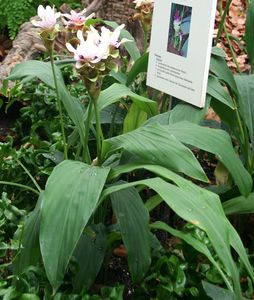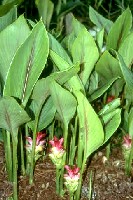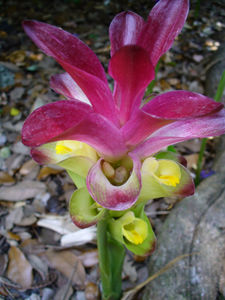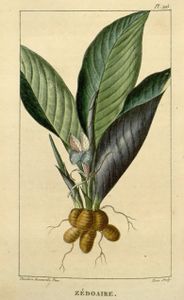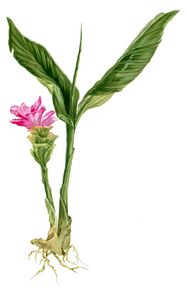Curcuma picta
Curcuma picta
Roxb. ex Škorničková
| Ordre | Zingiberales |
|---|---|
| Famille | Zingiberaceae |
| Genre | Curcuma |
2n =
Origine : Inde du Nord-Est ?
sauvage et cultivé
| Français | zédoaire |
|---|---|
| Anglais | zedoary |
- rhizome consommé, riche en amidon
- rhizome médicinal, mangé pour donner bonne haleine,
et utilisé en parfumerie - jeunes pousses et inflorescence consommées comme légume
- feuilles condimentaires
Sommaire
Description
- plante herbacée pérenne
- rhizome ramifié, gris, à chair jaunâtre à jaune vif
- feuilles à gaine de 35-60 cm de long, limbe oblong à oblong-lancéolé, de 25-75 cm de long, à bande pourpre sur la nervure centrale
- inflorescences sur des pousses séparées
- bractées vertes, parfois à bord pourpre, bractées supérieures pourpres ou rose foncé
- corolle de 3,5-4,5 cm de long, blanc-jaunâtre
L'espèce croît en milieu ombragé humide jusqu'à 1000 m d'altitude.
Noms populaires
| français | zédoaire |
| anglais | zedoary, shoti, Indian arrowroot, white turmeric |
| allemand | Zitwer, Zitwerwurzel |
| néerlandais | zedeware, zeduar (Moyen-Age), maagwortel, zedoarwortel |
| espagnol | cedoaria |
| portugais | zedoária |
| italien | zedoaria |
| arabe | زدوار - zadwār, جَدْوَار - ǧadwār ; زرمباد - zerumbad (Garcia da Orta) |
| persan | زدوار - zadwār (Steingass) |
| sanskrit | shathi, sathi, draavida, durlabha, gandhamūlaka, gandhasara, jatala, kachura, kalpaka, karshya, mukhya, narkachūr, vedya (Gurudeva); ṡaṭi, शढी - ṡaḍhī (Monier-Williams); करचूरा karcūrā (Garcia da Orta) |
| hindi | कचूर - kacūra ; amb halad, gandhmul (Gernot Katzer) |
| nepali | कचूर - kachur (Gernot Katzer) |
| kannada | ಕಚೋರ - kachora (Gernot Katzer) |
| malayalam | കച്ചൂരം - kachuram, kacchuram (Gernot Katzer) |
| oriya | କେଦାର - kedar (Gernot Katzer) |
| tamoul | kachora, kasthūri manjil, kichhilik kishangu, pulankilhangu (Gurudeva) |
| thaï | khamin khun (nord), khamin oi (central) (PROSEA) ; ขมิ้นหัวขึ้น, ขมิ้นขึ้น, ขมิ้นอ้อย, ขมิ้นขาว - khamin hua khuen, khamin khun, khamin oi, khamin khao (Gernot Katzer) |
| indonésien | koneng tegal (sundanais), temu putih (malais, Jakarta) (PROSEA) |
| malais | temu kuning, kunchur, temu lawak (péninsulaire) (PROSEA) |
| Philippines | alimpuyas (Cebu Bisaya), barak (tagalog), tamahilan (bikol) (PROSEA) |
| birman | thanuwen (PROSEA) |
| Cambodge | prâtiël prèah 'ângkaôl (PROSEA) |
| Laos | 'khmin2 khai (PROSEA) |
| Vietnam | nghệ den, nga truật, ngải tím (PROSEA) |
| chinois | 莪朮 - é-zhú, 鬱金 - yù jīn (Gernot Katzer) |
| chinois cantonais | 莪朮 - ngoh seuht, 鬱金 - wāt gām (Gernot Katzer) |
| japonais | 莪朮, ガジュツ - gajutsu (Gernot Katzer) |
| coréen | 아출, 봉출, 가쥬츠, 커큐머 제도 - achul, pongchul, kajyuchu, keokyumeo jedo, kokyumo jedo (Gernot Katzer) |
Classification
Curcuma picta Roxb. ex Škorničková (2008)
synonymes :
- Amomum zedoaria Christmann (1779)
- Curcuma zedoaria auct. non (Christm.) Rosc. (1807)
- Curcuma zerumbet auct. non Roxburgh (1810)
Note : étant donné la confusion assez générale avec Curcuma zedoaria (Cristm.) Roscoe, espèce sauvage endémique du Kérala, les références doivent toutes être vérifiées.
Cultivars
Histoire
Usages
- Voir les Plantes médicinales du Cambodge, du Laos et du Viêtnam de Petelot (1952-1954) (Curcuma zedoaria)
Mainly cultivated in S and south-eastern Asia. Also cultivated in Madagascar. The rhizomes (Rhizoma Zedoariae) are used medicinally. For the oil, obtained by distillation, the rhizomes have been exported to Europe already in the Middle Ages (in Europe known since the 6th and 7th cent.). The starch (shoti starch), obtained from the rhizomes, serves as food. The young rhizomes are eaten as vegetables. The rhizomes are utilized also for the production of liqueur.
Cultivé dans toute l'Asie du Sud-Est, en Chine et à Taïwan.
Références
- Burkill, I.H., 1966. A dictionary of the economic products of the Malay Peninsula. Revised reprint. 2 volumes. Ministry of Agriculture and Co-operatives, Kuala Lumpur, Malaysia. Vol. 1 (A-H) pp. 1-1240. Vol. 2 (I-Z) pp. 1241-2444.
- Burtt, B.L., 1977. Curcuma zedoaria. Gardens' Bulletin, Singapore, 30: 59-62.
- Chauvet, Michel, 2018. Encyclopédie des plantes alimentaires. Paris, Belin. 880 p. (p. 788)
- Council of Scientific and Industrial Research, 1948-1976. The wealth of India: a dictionary of Indian raw materials & industrial products. 11 volumes. Publications and Information Directorate, New Delhi, India.
- Holttum, R.E., 1950. The Zingiberaceae of the Malay Peninsula. Gardens' Bulletin, Singapore, 13(1): 1-249.
- Hwang, W.I., Cha, S. & Lee, S.Y., 1980. Extraction of anticancer components from Korean medicinal plants and the determination of their cytotoxic activities on the cancer cells. Korean Biochemical Journal, 13(1): 25-40.
- Leong-Škorničková, J. et al., 2008. Taxonomic and nomenclatural puzzles in Indian Curcuma: the identity and nomenclatural history of C. zedoaria (Christm.) Roscoe and C. zerumbet Roxb. Zingiberaceae). Taxon, 57: 949–962.
- Leong-Škorničková, J. et al., 2010. Back to types! Towards stability of names in Indian Curcuma L. (Zingiberaceae). Taxon, 59: 269–282. en ligne
- Mangaly, J. K. & Sabu, M., 1993. A taxonomic revision of the South Indian species of Curcuma Linn. (Zingiberaceae). Rheedea, 3(2): 139-171.
Liens
- BHL
- FAO Ecocrop (Curcuma zedoaria)
- Gernot Katzer's Spice pages (Curcuma zedoaria)
- Grieve's herbal (Curcuma zedoaria)
- GRIN
- IPNI
- Mansfeld (Curcuma zedoaria)
- Multilingual Plant Name Database
- Plant List
- Plants of the World Online
- PROSEA sur Pl@ntUse
- Useful Tropical Plants Database (Curcuma zedoaria)
- Wikipédia (Curcuma zedoaria)
- World Flora Online

